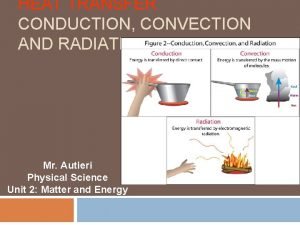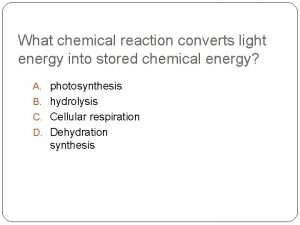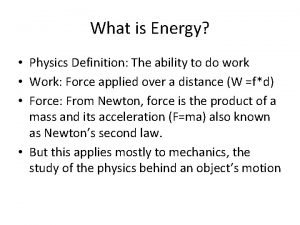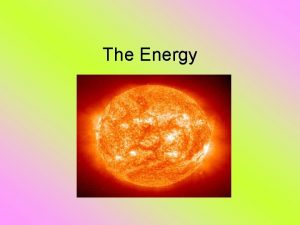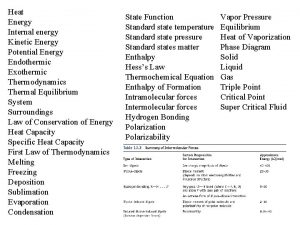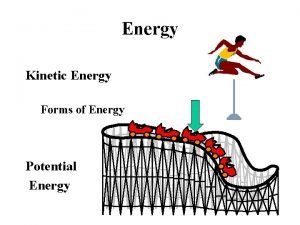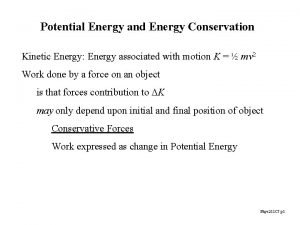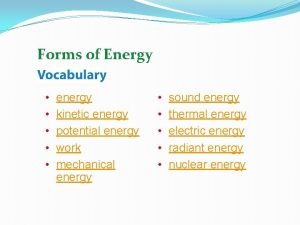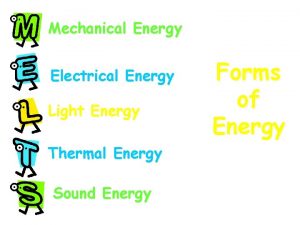Radiation Definition of Radiation Radiation is an energy







































- Slides: 39

Radiation

Definition of Radiation • “Radiation is an energy in the form of electro-magnetic waves or particulate matter, traveling in the air. ”

Types of Radiation • Radiation is classified into: – Ionizing radiation – Non-ionizing radiation


Ionization Ionizing radiation is produced by unstable atoms. Unstable atoms differ from stable atoms because they have an excess of energy or mass or both. Unstable atoms are said to be radioactive. In order to reach stability, these atoms give off, or emit, the excess energy or mass. These emissions are called radiation.

Classification of Radiation • Non-ionizing radiation cannot ionize matter because its energy is lower than the ionization potential of matter. • Ionizing radiation can ionize matter either directly or indirectly because its energy exceeds the ionization potential of matter. It contains two major categories: – Directly ionizing radiation (charged particles) electrons, protons, alpha particles, heavy ions – Indirectly ionizing radiation (neutral particles) photons (x rays, gamma rays), neutrons 6

Ionizing Versus Non-ionizing Radiation Ionizing Radiation – Higher energy electromagnetic waves (gamma) or heavy particles (beta and alpha). – High enough energy to pull electron from orbit. Non-ionizing Radiation – Lower energy electromagnetic waves. – Not enough energy to pull electron from orbit, but can excite the electron.

Another Definition Ionizing radiation A radiation is said to be ionizing when it has enough energy to eject one or more electrons from the atoms or molecules in the irradiated medium. This is the case of a and b radiations, as well as of electromagnetic radiations such as gamma radiations, X-rays and some ultra-violet rays. Visible or infrared light are not, nor are microwaves or radio waves.

Radioactivity • If a nucleus is unstable for any reason, it will emit and absorb particles. There are many types of radiation and they are all pertinent to everyday life and health as well as nuclear physical applications.

Types or Products of Ionizing Radiation neutron or X-ray

Radioactive Atom Ionizing Radiation alpha particle X-ray beta particle gamma ray

• The electro-magnetic waves vary in their length and frequency along a very wide spectrum.




Primary Types of Ionizing Radiation Alpha particles Beta particles Gamma rays (or photons) X-Rays (or photons) Neutrons

Types and Characteristics of Ionizing Radiation Alpha Particles: 2 neutrons and 2 protons They travel short distances, have large mass Only a hazard when inhaled

• Alpha Particles (or Alpha Radiation): Helium nucleus (2 neutrons and 2 protons); +2 charge; heavy (4 AMU). Typical Energy = 4 -8 Me. V; Limited range (<10 cm in air; 60µm in tissue); High LET (QF=20) causing heavy damage (4 K-9 K ion pairs/µm in tissue). Easily shielded (e. g. , paper, skin) so an internal radiation hazard. Eventually lose too much energy to ionize; become He.

Beta Particles: Electrons or positrons having small mass and variable energy. Electrons form when a neutron transforms into a proton and an electron or:

• Beta Particles: High speed electron ejected from nucleus; -1 charge, light 0. 00055 AMU; Typical Energy = several Ke. V to 5 Me. V; Range approx. 12'/Me. V in air, a few mm in tissue; Low LET (QF=1) causing light damage (6 -8 ion pairs/µm in tissue). Primarily an internal hazard, but high beta can be an external hazard to skin. In addition, the high speed electrons may lose energy in the form of X-rays when they quickly decelerate upon striking a heavy material. This is called Bremsstralung (or Breaking) Radiation. Aluminum and other light (<14) materials are used for shielding.


Gamma Rays (or photons): Result when the nucleus releases energy, usually after an alpha, beta or positron transition

X-Rays: Occur whenever an inner shell orbital electron is removed and rearrangement of the atomic electrons results with the release of the elements characteristic X-Ray energy

• X- and Gamma Rays: X-rays are photons (Electromagnetic radiations) emitted from electron orbits. Gamma rays are photons emitted from the nucleus, often as part of radioactive decay. Gamma rays typically have higher energy (Mev's) than X-rays (Ke. V's), but both are unlimited.

Neutrons: Have the same mass as protons but are uncharged



Non-ionizing Radiation • Definition: “ They are electromagnetic waves incapable of producing ions while passing through matter, due to their lower energy. ”

– The sun emits radiation composed of high energy infrared radiation, visible light, and ultraviolet radiation collectively known as shortwave radiation (SW) – The earth emits radiation composed of lower energy infrared radiation collectively known as long-wave radiation (LW)


Path of incoming solar radiation

Examples on Non-ionizing Radiation Sources Visible light Microwaves ULTRA V Radios INFRARED Video Display Terminals TV AM Power lines RF Radiofrequency Diathermy (Physical Therapy) Lasers GAMMA VISIBLE MICROWAVE

Other Manmade Sources of Non. Ionizing Radiation



Effects l Radiofrequency Ranges (10 k. Hz to 300 GHz) – – Effects only possible at ten times the permissible exposure limit Heating of the body (thermal effect) Cataracts Some studies show effects of teratoginicity and carcinogenicity.

RADIATION CONTROLS • A. Basic Control Methods for External Radiation l Decrease Time l Increase Distance l Increase Shielding


 Energy energy transfer and general energy analysis
Energy energy transfer and general energy analysis Energy energy transfer and general energy analysis
Energy energy transfer and general energy analysis Radiation hazards definition
Radiation hazards definition Radiation interior design examples
Radiation interior design examples Radiation floral design definition
Radiation floral design definition Convection radiation conduction
Convection radiation conduction Section 1 work and machines section 2 describing energy
Section 1 work and machines section 2 describing energy Potential energy of a spring at equilibrium
Potential energy of a spring at equilibrium Primary energy and secondary energy
Primary energy and secondary energy Hypdro
Hypdro Gibbs free energy and spontaneity
Gibbs free energy and spontaneity How to find free energy
How to find free energy Conservation of mechanical energy formula
Conservation of mechanical energy formula How are thermal energy and temperature different
How are thermal energy and temperature different A hairdryer converts ____ energy into ____ energy.
A hairdryer converts ____ energy into ____ energy. Electric potential energy formula
Electric potential energy formula How to convert mechanical energy to electrical energy
How to convert mechanical energy to electrical energy Section 3 using thermal energy answers
Section 3 using thermal energy answers Is delta g free energy
Is delta g free energy Helmholtz free energy
Helmholtz free energy As nutritional energy passes through the food chain, energy
As nutritional energy passes through the food chain, energy Usable chemical energy in food begins as __________ energy.
Usable chemical energy in food begins as __________ energy. Chapter 7 energy conservation of energy
Chapter 7 energy conservation of energy Wind power is an indirect form of solar energy
Wind power is an indirect form of solar energy ________ converts light energy into chemical energy. *
________ converts light energy into chemical energy. * Kinetic energy gravity
Kinetic energy gravity Definition of elastic potential energy
Definition of elastic potential energy What is this area
What is this area Physics definition of energy
Physics definition of energy Examples of mechanical energy at home
Examples of mechanical energy at home Gravitational potential energy vs kinetic energy
Gravitational potential energy vs kinetic energy Efficiency = useful power output
Efficiency = useful power output Thermal energy and mass
Thermal energy and mass Renewable energy and energy efficiency partnership
Renewable energy and energy efficiency partnership Potential kinetic energy
Potential kinetic energy Examples of kinetic energy
Examples of kinetic energy Potential energy of a spring at equilibrium
Potential energy of a spring at equilibrium Kinetic energy and potential energy formula
Kinetic energy and potential energy formula Conservation of mechanical energy
Conservation of mechanical energy Energy forms and energy conversions
Energy forms and energy conversions





